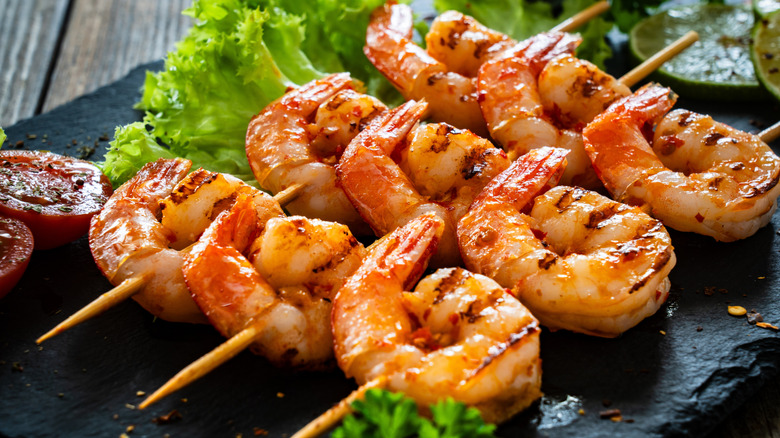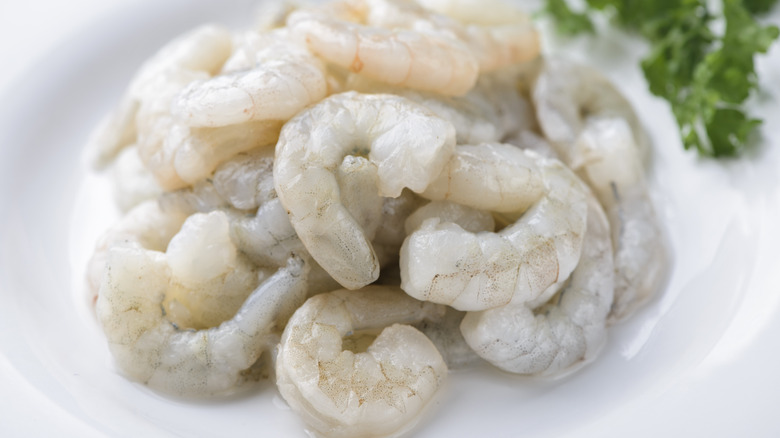Why It Pays To Dry-Brine Shrimp
While delicious, shrimp are prone to overcooking quite easily. To avoid this, try dry brining. This sounds complicated, but it really isn't — and you can use it on just about anything, from shrimp to a smoked turkey. The process, essentially, involves salting your food prior to cooking and leaving it to rest for a few hours — this avoids soaking meat (or fish) in excess moisture like traditional brining does, potentially diluting its flavors, and letting you achieve a lovely crispy crust (which works beautifully on pork chop, for example). It will leave you with a much more flavorful final product, and also tenderizes your proteins, making them more resistant to overcooking.
To find out more about dry-brining shrimp, Food Republic spoke to chef Simpson Wong, of Kancil, a Malaysian restaurant in New York. "I dry brine the shrimps to achieve a bouncy texture," he said. Dry brining, especially if you use baking soda, helps the muscle retain moisture when cooking, which means your seafood won't get chewy and dry. Wong noted, "When shrimps are seared in a high heat, they tend to shrivel and shrink in size, and [they become] dry, much like microwaving a piece of meat. The baking soda helps to prevent that somewhat."
That perfectly tender bite is what you want from perfectly cooked shrimp — if it's overdone, it'll result in a dry, rubbery texture. Chef Wong doesn't recommend using this method for larger shellfish, like wild prawns: "We serve these split and shell on, and only split them when orders come in." Prawns are usually larger, so they can hold up to different types of cooking better than their smaller cousins.
How to dry brine shrimp at home
The key to a dry brine is to nail the perfect mixture. Chef Wong recommends using a simple brine of salt, sugar, and baking soda. The ratio is similarly simple: "1 part salt, ½ part sugar, ¼ part baking soda." The salt will take care of the tenderizing of the meat. Instead of leading to excess water absorption like traditional brining, this method extracts the protein's own juices to create an intense, salty brine. That is then reabsorbed back into the meat, keeping it moist but the outside dry. The sugar adds sweetness and depth of flavor, and will also result in the brining mixture beginning to mildly cure the shrimp. The curing helps to break down proteins in the meat, resulting in a more tender texture and deeper flavor profile.
Chef Simpson Wong stated, "Some chefs soak the shrimps in baking soda and water to achieve the crunch and bounce, and it's very similar to dry brining." Baking soda is a fantastic way to tenderize meat -– it's been a mainstay in Chinese cooking for years. The chemicals in the baking soda change the proteins' pH (or acidity, which stops the meat from seizing up as it cooks). That results in a much more tender bite. It's not just great for shrimp, either — after all, it's the ingredient your stir-fry has been missing. In fact, it's why moo goo gai pan is superior to your standard stir-fry.
Another great way to get some flavor into your shrimp is by mixing spices into the dry brine. What spices you use will determine the flavor profile of your final dish. Chef Wong uses "chili flakes [and] turmeric powder" for a balance of earthiness and subtle heat.


